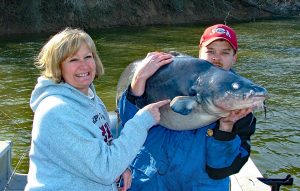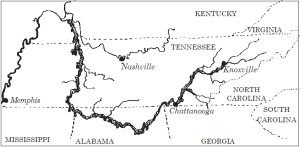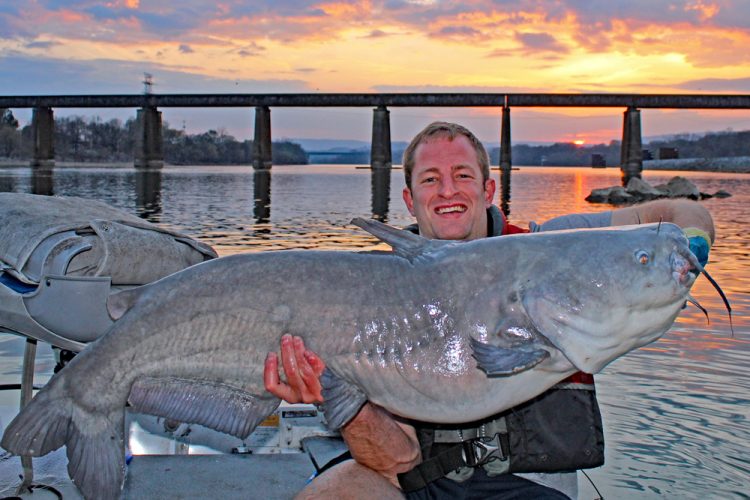Capt. Sam Simons shows off a monster blue taken inside the city limits of Chattanooga, in the tailwaters of Chickamauga Dam. While TVA dams built 80 years ago negatively impacted some species, biologists say the creation of the reservoirs actually favored catfish.
Tennessee River: A 652-Mile Catfish Factory
by Richard Simms
The nine reservoirs on this southeastern waterway churn out enormous numbers of monster catfish.
“The Tennessee River is a catfish factory.”
That is a standard line I have used with clients of my catfishing guide business, based on the Tennessee River, routinely for nearly 20 years. Mike Jolley, Regional Reservoir Biologist for the Tennessee Wildlife Resources Agency, agrees.
“That’s true, absolutely,” said Jolley. “Except for our 34-inch trophy regulation, there is little management for catfish. (The Tennessee River) really is a factory. Years ago, when dams were built, they negatively impacted some species. But the creation of the reservoirs actually favored the catfish. The river’s best elements include food and habitat availability. They are nutrient-rich reservoirs, and catfish have made the best of it.”

Those nutrients come from the 40,910 square miles, over a seven-state area, that drain into the Tennessee River. In my time guiding literally thousands of catfishing trips, I can proudly say that I have only done two trips where we failed to catch a single catfish. I may not have caught as many as I wanted to catch on every trip, but with just a little know-how, it is hard for a good catfisherman to get skunked on the Tennessee River.
From where the river begins—at the confluence of the Holston and French Broad rivers near Knoxville, Tennessee—to where it empties into the Ohio River in western Kentucky, the Tennessee River is 652 miles long. It is broken up by large Tennessee Valley Authority (TVA) dams into nine major reservoirs. Upstream to downstream, in order, they include Fort Loudoun, Watts Bar, Chickamauga, Nickajack, Guntersville, Wheeler, Wilson, Pickwick and Kentucky lakes.
Ron Presley, former Editor of CatfishNOW Magazine, said, “When I think of the best catfishing waters in the country, three locations come immediately to mind. The three include the Santee Cooper lakes, the James River, which I have never fished, and the Tennessee River, which produced my personal best 82-pound blue cat.”
Capt. Sam Simons, a Tennessee River catfishing guide based in Chattanooga, said, “When I think about the three best catfishing waters, I think about the Tennessee River, the James River and the Mississippi River. I think you could argue over which one is number one based on your regional location and preference over size and quantity. But I just know I’ve caught a lot of catfish of various sizes from six of the nine Tennessee River reservoirs (and haven’t fished the others).”
Capt. Mark Nawrocki, a catfish guide based north of Capt. Simons near Knoxville, Tennessee, said, “I believe the Tennessee River is in the top five. It is hard to compete with the James River or the Mississippi River for number one or two.”
Capt. Mike Mitchell, a Tennessee River catfish guide based in North Alabama, waffles back and forth a little bit, saying, “I’m very fond of the Mississippi River because I prefer current. The Tennessee River is not really as productive year-round due to lack of current and flow. But catching fish in the 50- to 75-pound range, the Tennessee is the best I’ve been able to fish. But since I’ve been spending some time of the Mississippi the last three years, I’ve caught a 90-pounder and a 97-pounder. The Mississippi may be slightly better for fish over 80 pounds, in my opinion, but it’s very hard to fish year-round due to water levels.”

All the experts agree that the Tennessee River fishes basically the same as any of the other top catfishing spots. Whether it’s anchor fishing, suspend drifting or dragging planer boards, it is all pretty much the same. It is simply a matter of making the necessary adjustments for water depth and current flow.
All four men have also seen an increase in the interest in catfishing on the Tennessee River.
“That shows up all the time in our guide business, as many clients travel from long distances to fish for catfish,” said Capt. Simons.
Capt. Nawrocki said, “Due to (the Tennessee River’s) location, not too far from the northern lakes, it put the sport of catfishing on the map. Catfishing started to get popular on the Ohio River, but large trophy cats came into play when folks found the Tennessee River.”
Capt. Mitchell said, “The Tennessee River has become very popular, especially Wheeler Reservoir where you see a lot of out-of-state boats, and larger tournaments have been coming there for years. But I think there are still parts (of the Tennessee River) that get very little pressure and notoriety when it comes to trophy catfishing.”
Blue catfish are by far the predominant species on the Tennessee River. There are flatheads and channel catfish in good numbers, but blue cats make up the lion’s share of the catch. Capt. Simons admits that he does miss catching larger channel catfish. On the Tennessee River, channel catfish, while plentiful, don’t often get bigger than 10 pounds.

Capt. Simons adds, however, “The headwaters of Guntersville Reservoir are known for a healthy flathead population. It is a favorite springtime spot for the flathead enthusiasts.”
Most agree that one of the best things about catfishing on the Tennessee River is its consistency—spring, summer, fall and even winter.
“One thing that has surprised me after a few years of fishing the Tennessee River is the winter fishing,” said Presley. “It is indeed a year-round fishery, and anglers don’t have to hang up their rods and reels.”
But there might be one downside to the river’s consistency and fame.
“Big trophy cats are harder to find due to pressure,” said Capt. Nawrocki. “I have seen the fishing drop off. It was commonplace to catch a 40- or 50-pound fish. Lately I’ll get about five a year.”
Of course, publicity generated by the catfish guides themselves is in part responsible for the added pressure. As an active guide and regular top-finisher in major catfish tournaments, Capt. Mitchell has been featured in numerous major outdoor and fishing magazines and websites, including CatfishNOW.

“Fishing pressure plays a big factor (on the Tennessee River),” said Mitchell. “It’s harder than before. I think the fish are still there. We still we have tons of natural forage and (due to regulations) not that many fish over 34 inches are taken out. But a lot of those catch-and-release fish just seem like they wise up or change habits when caught repeatedly.”
“I feel like the catfishing has stayed the same from the beginning of my guiding career 12 years ago,” said Capt. Simons. “The only difference I notice is a lot more people are catfishing now which has added to the fish being pressured.”
Capt. Simons and his guide partners have also generated a lot of buzz about the Tennessee River in recent years with several “white catfish” catches.
“For years and years, nobody saw a leucistic blue cat, at least nobody that I knew,” said Capt. Simons. “I saw my first about five years ago. It was a beautiful 15-pound white (leucistic) catfish with pink and touches of black. Less than a year later, one of my clients had a 20-pound-class piebald break off at the boat. My guide partners and I have caught eight or nine leucistic (piebald) blues in recent years. They’re clearly reproducing and being released. I’m anxious to see if the trend continues.”
Presley wraps it up, saying no matter what your preferred fishing technique, you can use it on the Tennessee River.
“While some waters lend themselves more to one technique than to another, the Tennessee River is adaptable to multiple techniques on any given day,” said Presley. “Power generation and water releases from the TVA dams often dictate the kind of fishing anglers choose. This creates a challenge and a blessing for anglers. But it is also the beauty of fishing these waters. If anglers prefer a certain technique, from bumping to anchoring and everything in between, they can find a place and time to apply their skills on the Tennessee River.”
(Capt. Richard Simms is the Editor of our sister magazine, CrappieNOW magazine. He is also a “semi-retired,” fishing guide on the Tennessee River and owner of Scenic City Fishing Charters. Formerly he was a game warden for the Tennessee Wildlife Resources Agency before becoming a photographer and PR guy for TWRA. That lead to a 30-year career as a broadcast journalist and freelance outdoor writer. Check out his book, “An Outdoor State of Mind.”)



